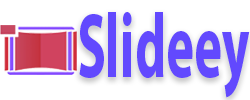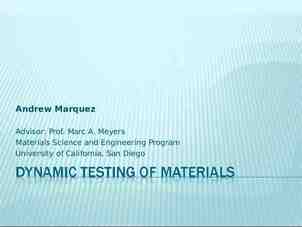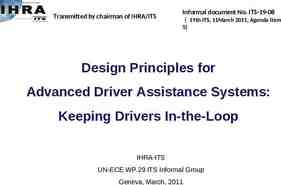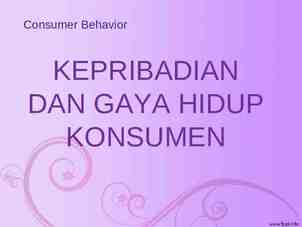Introduction to knowledge management 1
70 Slides6.77 MB

Introduction to knowledge management 1
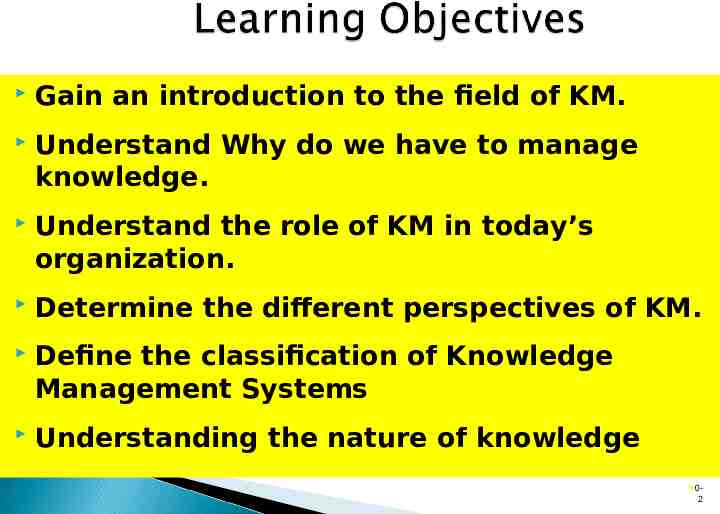
Gain an introduction to the field of KM. Understand Why do we have to manage knowledge. Understand the role of KM in today’s organization. Determine the different perspectives of KM. Define the classification of Knowledge Management Systems Understanding the nature of knowledge 0- 2

Cases 0 -3

In one company, the financial manager decided to reduce the budget by laying off some employees . One of them was the best maintenance engineer. After some months, one machine stopped working due to damage of some parts the company tried many times to fix it, but it could not. So it is forced to engage the engineer himself to repair that machine . Actually the engineer installed that part using his hammer for the convenience of the new part and put it in the right position so he returned the machine to work in minutes. After that he made a repair bill of 1000. However , the cost of the hammer by the engineer installed did not exceed one dollar? Can you justify ( 999)!. 0 -4

One financial firm faced a complex problem due to the mistakes of mathematical accumulated since the exit of financial manager of retirement. After that; many problems had been happened related to taxes and funded with many companies and banks. For solving these problems, several committees had been formed without any results, So the company decided to outsource the financial manager himself who had been able to solve the problem within three days After that, he had submitted an invoice for resolving these problems account in the amount of 5,000, and when he asked about the actual amount used to accomplish the work during Three days it was 500 only Do you have any justification for ( 4,500)! 0 -5

0 -6

According to the resource-based view of the firm Knowledge has become the key strategic resource, This theory attempts to explain and predict why some firms are able to establish positions of sustainable competitive advantage and, in so doing, earn superior returns. According to this theory; Knowledge can easily meet the four conditions to be strategic assets 1. It is Rare 2. It can add value 3. It can not be replaced 4. It can not be imitated 0- 7

Marketplaces are increasingly competitive and the rate of innovation is rising. Reductions in staffing create a need to replace informal knowledge with formal methods. Competitive pressures reduce the size of the work force that holds valuable business knowledge The amount of time available to experience and acquire knowledge has diminished 0- 8

Changes in strategic direction may result in the loss of knowledge in a specific area. Early retirements and increasing mobility of the work force lead to loss of knowledge. 0- 9

(KM) may be defined simply as doing what is needed to get the most out of knowledge resources. (KM) focuses on organizing and making available important knowledge, wherever and whenever it is needed. (KM) is highly related to the concept of intellectual capital (both human and structural. 0- 1 0

Increasing Domain Complexity Accelerating Market instability Intensified Speed of Responsiveness Diminishing Individual Experience 0- 1 1

Knowledge management provides benefits to individual, to communities of practice, and to the organization itself. 0- 1 2

Helps people do their jobs and save time through better decision making and problem solving Helps people to keep up to date Provides challenges and opportunities to contribute 0- 1 3
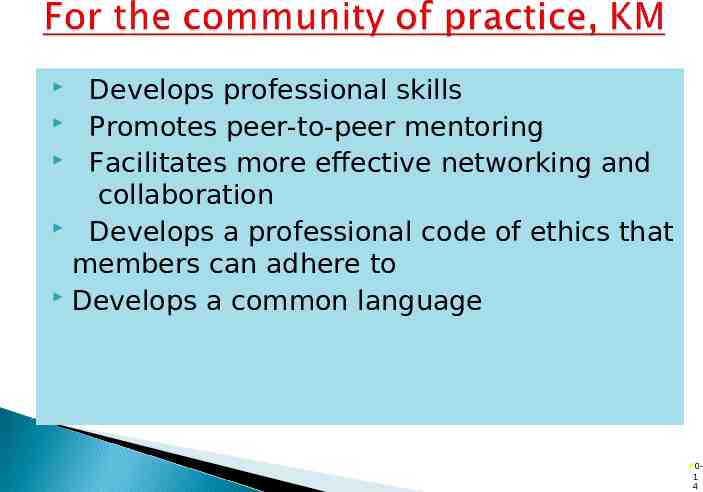
Develops professional skills Promotes peer-to-peer mentoring Facilitates more effective networking and collaboration Develops a professional code of ethics that members can adhere to Develops a common language 0- 1 4

Helps drive strategy Solves problems quickly Diffuses best practices Improves knowledge embedded in products and services Cross-fertilizes ideas and increases opportunities for innovation Enables organizations to better stay ahead of the competition Builds organizational memory 0- 1 5
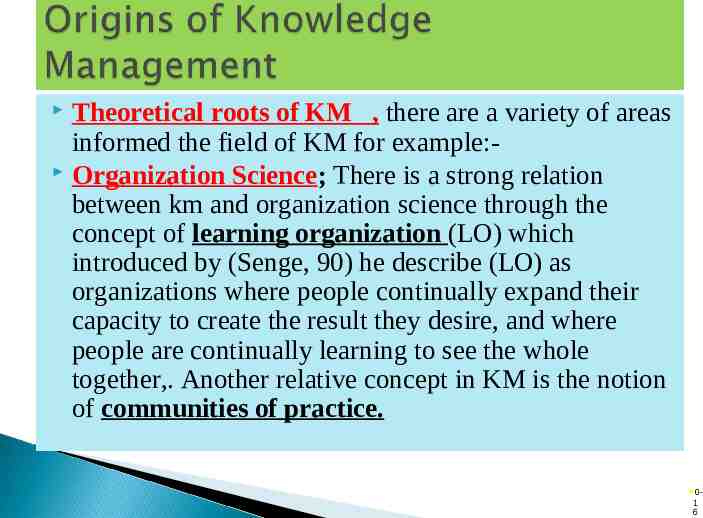
Theoretical roots of KM , there are a variety of areas informed the field of KM for example: Organization Science; There is a strong relation between km and organization science through the concept of learning organization (LO) which introduced by (Senge, 90) he describe (LO) as organizations where people continually expand their capacity to create the result they desire, and where people are continually learning to see the whole together,. Another relative concept in KM is the notion of communities of practice. 0- 1 6
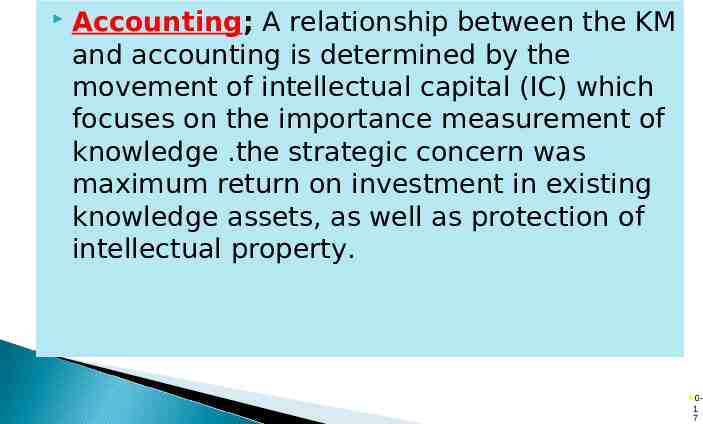
Accounting; A relationship between the KM and accounting is determined by the movement of intellectual capital (IC) which focuses on the importance measurement of knowledge .the strategic concern was maximum return on investment in existing knowledge assets, as well as protection of intellectual property. 0- 1 7

Human Resource Management; HRM is playing the important role in growing KM field through the concept of knowledge works and knowledge worker . Compared to traditional form of work, knowledge work has a broader scope, and less predictable Thus, it cannot be managed directly , also the knowledge worker as a new trend with some special characteristics (will be explained in details in the next chapter) requires a significant degree of job autonomy and flexibility, and need different incentive systems to get committed. As a result there is a need for different management provided by HRM. 0- 1 8

Information technology ; KM is depending mainly on the new IT applications to support the km processing .The most common type of imitative was building repositories of specific type of knowledge for use in particular business functions . Beside the implementation of IT application, there are many specific roles and positions created to advance KM agenda in organizations. As example designing knowledge architectures, and redesigning knowledge work process and activities. The following figure can summarize the main root of KM. 0- 1 9
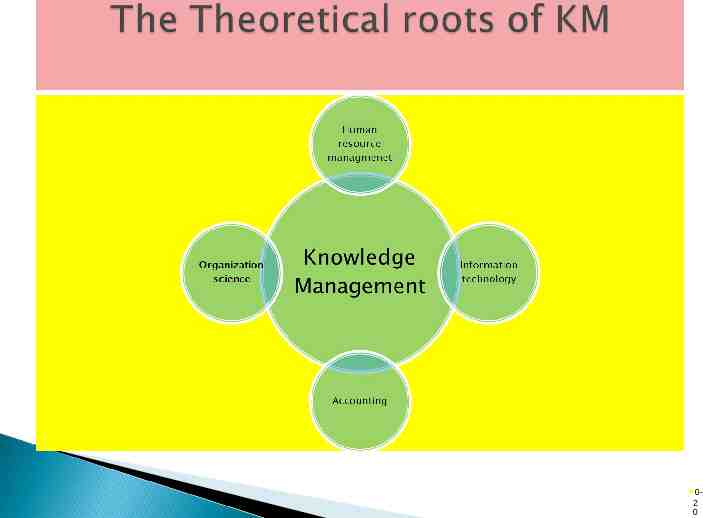
0- 2 0

Two fundamental shifts are essential for emerged KM; 1.Downsizing During the 1980, downsizing was the popular strategy to reduce overhead costs and increase profits; however, the downside to being “lean and mean “soon became evident .Over time a successful downsizing strategy led to important knowledge has been lost , as employees left and took the knowledge that they had accumulated over the years with them , this led management to undertake a KM as a tool to retain and keep on employees’ knowledge and experts for a long time. By the way organizations have been more interested in using the more advanced IT to capture employees’ knowledge and disseminate it within and between organizational units to be more satisfied. 0- 2 1

2- Technology development The technology development has highlighted the interest in KM through two main sources; the explosive growth of information resources such as (the internet) and the accelerating pace of technological change. The recent IT development has affected both the lives of people and organizations. Thus KM is an attempt to cope with the explosion of information and to capitalise on increased knowledge in the workplace. On the other hand, the emerging technological development enables global sharing of information across different countries, and can serve a tool within an organization to use knowledge more effectively. 0- 2 2

Knowledge management systems (KMS): the synergy between social/structural mechanisms and latest technologies. 0- 2 3

Knowledge discovery & creating systems Knowledge capture systems Knowledge sharing systems Knowledge application systems 0- 2 4

80% - Organizational processes and human factors 20% - Technology PEOPLE OVERLAPPING FACTORS ORGANIZATIONAL PROCESSES TECHNOLOGY 0- 2 5

Knowledge is first created in the people’s minds. KM practices must first identify ways to encourage and stimulate the ability of employees to develop new knowledge. 0- 2 6

KM technologies must enable effective ways to extract, create, represent, organize, re-use, and renew this knowledge KM should not distance itself from the knowledge owners, but instead celebrate and recognize their position as experts in the organization 0- 2 7

lecture No (2) 2 8

As an essential part of KM is, of course, knowledge , so In order to comprehend knowledge management, it is necessary first to understand the concept of ?knowledge. What is knowledge 0- 2 9

Figure 2.1 Idealist and empiricist perspectives on knowledge 0- 3 0

Addressed knowledge as “Justified True Belief “ 0- 3 1
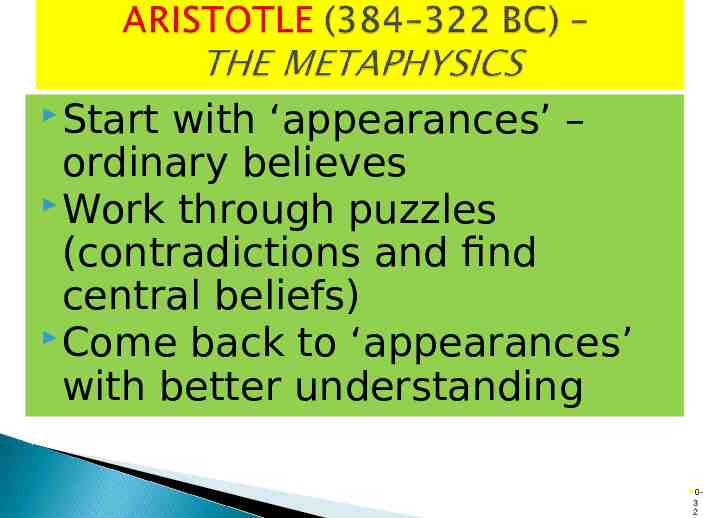
Start with ‘appearances’ – ordinary believes Work through puzzles (contradictions and find central beliefs) Come back to ‘appearances’ with better understanding 0- 3 2

Lay aside things on common-sense grounds that are doubtful Doubt you are recognizing or perceiving anything at any moment 0- 3 3

Which philosopher has the greatest influence on your thinking? 0- 3 4

0- 3 5

A great deal of conceptual challenge derives from the fact that a word such as knowledge is necessarily subjective in nature, not to mention value in interpretation. 0- 3 6

The definition of knowledge is extremely challenging :- Davenport & Prusak (1998 ) defined A Mix of experiences, values , information and expert insight that provides a framework for evaluating and creating new experience and information” knowledge as “ 0- 3 7

Brooking (1999 ) defined knowledge as “Information in context with understanding on how to use it”. 0- 3 8

Knowledge also defined as “ A meaning resulting from using the available information in high subjective context; that’s why the variances in meaning among people on the same things “ 0- 3 9

How is knowledge different from ?information and how is information different ?from data 0- 4 0

? Data is Unorganized and unprocessed facts; it can be considered as the basic or the raw material for creating information ,it is a set of discrete facts about events. Data is a number, word or letter without any context. For example, numbers like 5 or 100, without any context, are mere data. these numbers or data are meaningless points. It is called “out of context”. For example, movie listings; giving the times and locations of all movies being shown today. 0- 4 1
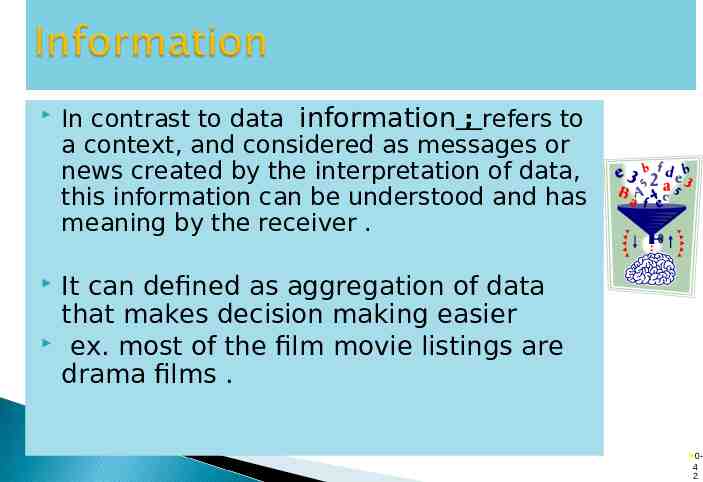
In contrast to data information ; refers to a context, and considered as messages or news created by the interpretation of data, this information can be understood and has meaning by the receiver . It can defined as aggregation of data that makes decision making easier ex. most of the film movie listings are drama films . 0- 4 2

Is derived from information in the same way information is derived from data; it is a person’s range of information knowledge involving the processing, creating, or use of information in the mind of individual, which mean that information has little value and will not become knowledge until it is processed by human mind. I'll watch a movie that I know heroes 0- 4 3

Knowledge Value Zero Low Medium High Very Data High Information 0- 4 4

Knowledge Counting H THTT H HHTH nH nT T pH nH/(nH nT) pT nT/(nH nT) EV pH RH pH 0.40 40 pT 0.60 60 RH 10 RT - 8 TTHT EV pT RT - 0.80 Information Data Value Zero Low Medium High Very High 0- 4 5

Knowledge Knowledge Data processing Information Use of information Knowledge Data Decision Event s 0- 4 6

As you are a traditional management student, which of the following statements would you describe as data, information or knowledge? A report on career progression prospects of MBA students. An Excel spreadsheet with questionnaire data on MBA students Critical success factors on interview success with your favored company A visit to an art exhibition The latest figures on unemployment The content list of your KM book. Travel to England at Christmas 0- 4 7

Figure 1.4 Data, information, knowledge and purposeful action 0- 4 8

knowing how to use information, it presents an integration of all aspects of the personality including affects, willing, cognition, and life experience 0- 4 9

Children have more need of models than of critics (French) You can’t see the whole sky through a bamboo tube (Japanese) There is plenty of sound in an empty barrel (Russian) Trust in Allah, but tie your camel (Muslim) Wonder is the beginning of wisdom (Greek) 0- 5 0
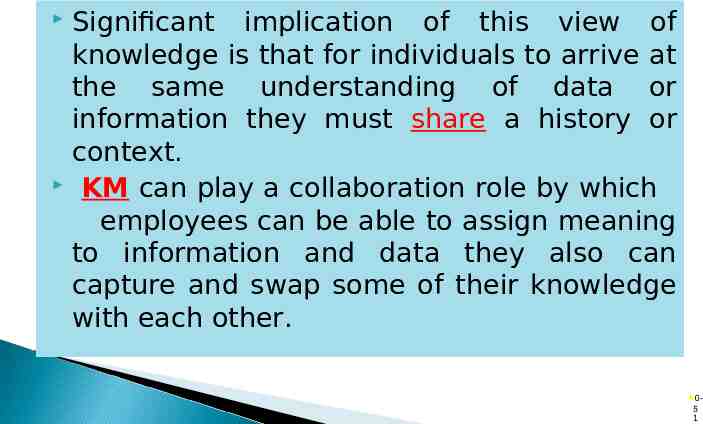
Significant implication of this view of knowledge is that for individuals to arrive at the same understanding of data or information they must share a history or context. KM can play a collaboration role by which employees can be able to assign meaning to information and data they also can capture and swap some of their knowledge with each other. 0- 5 1

What happened when you shared your colleagues knowledge ? 0- 5 2

Classification of “knowledge” 0- 5 3
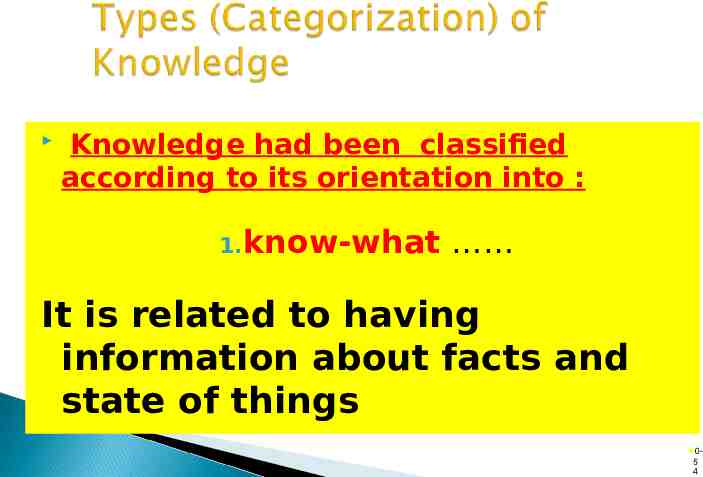
Knowledge had been classified according to its orientation into : 1.know-what It is related to having information about facts and state of things 0- 5 4

It is related to causal relationships between different element, it depends on the ability to articulate a conceptual understanding of an experience, it may called (conditional knowledge) 0 -55
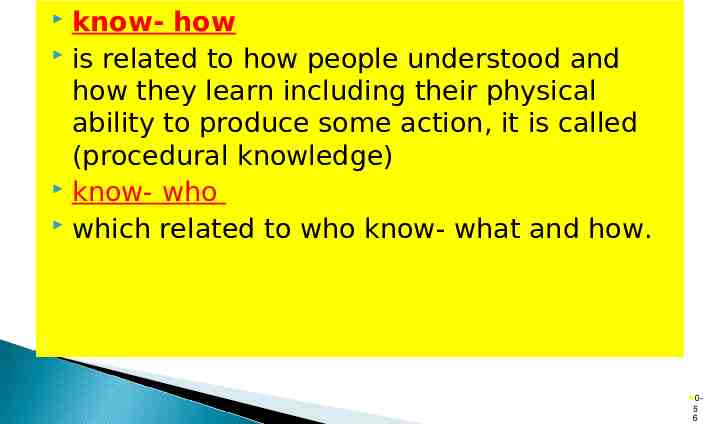
know- how is related to how people understood and how they learn including their physical ability to produce some action, it is called (procedural knowledge) know- who which related to who know- what and how. 0- 5 6
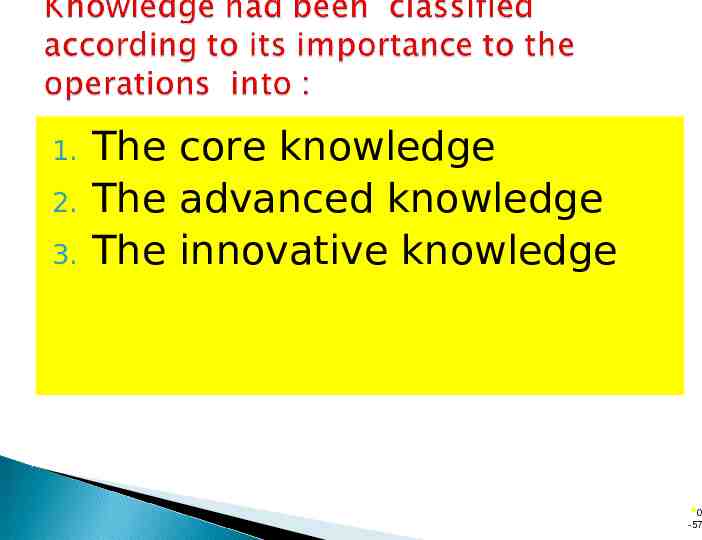
1. 2. 3. The core knowledge The advanced knowledge The innovative knowledge 0 -57

“ We know more than we can tell”. Polanyi 1966 According to Polani 1966 and Nonaka and Takeuchi (1995) identified the most famous categories of knowledge as Tacit knowledge & Explicit knowledge 0- 5 8
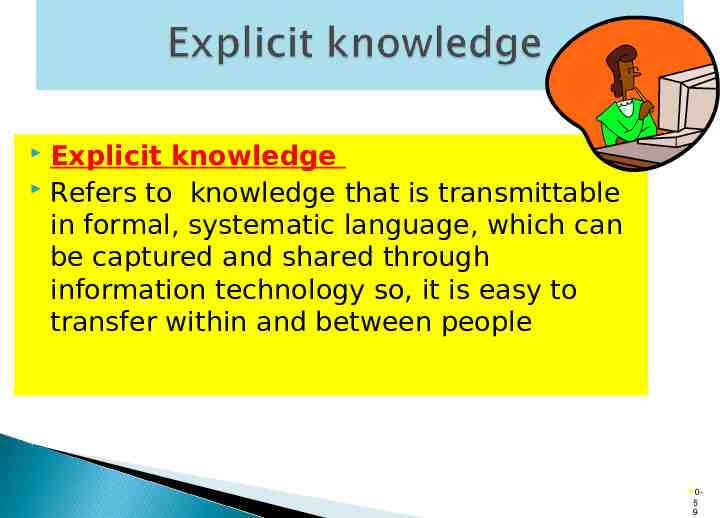
Explicit knowledge Refers to knowledge that is transmittable in formal, systematic language, which can be captured and shared through information technology so, it is easy to transfer within and between people 0- 5 9

Any organization supposes to obtain three types of explicit knowledge; Cognitive knowledge ; the basic discipline that professionals achieve through extensive training and certification Advanced skills ; the ability to apply rules of a discipline to complex real- world problem. System understanding ; the deep understanding of the web of cause – and effect relationships underlying a discipline 0- 6 0

Tacit knowledge; resides in the human mind, behavior, and perception It is derived empirically and held by the organization's employees It is hidden and refers to; intuitions and insights 0- 6 1

Although the view of knowledge as tacit and explicit is well known to date and involved in the majority of current literature on organizational knowledge Some scholars advocated that knowledge shouldn't seen as two separate types of knowledge. They suggested that all knowledge has both tacit and explicit components, and knowledge exists along a continuum of tacitness and explicitness For this reason it is existed a middle ground between tacit and explicit knowledge termed implicit knowledge that refers to the subset of tacit knowledge that can be transformed into explicit 0- 6 2
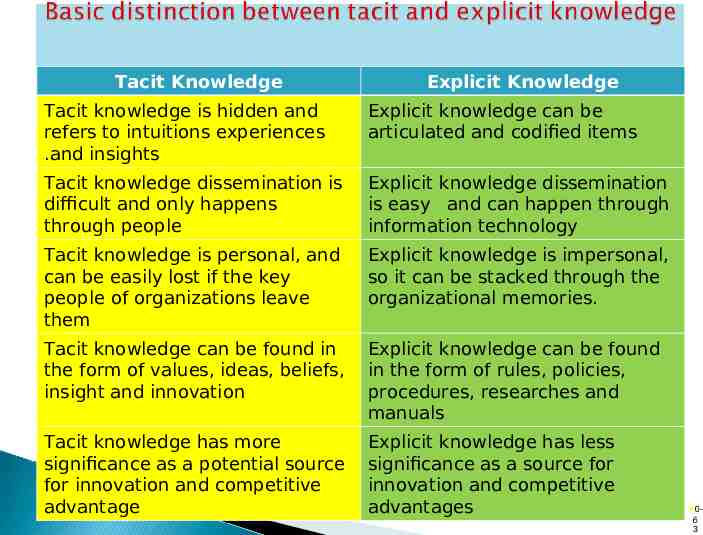
Tacit Knowledge Explicit Knowledge Tacit knowledge is hidden and refers to intuitions experiences .and insights Explicit knowledge can be articulated and codified items Tacit knowledge dissemination is difficult and only happens through people Explicit knowledge dissemination is easy and can happen through information technology Tacit knowledge is personal, and can be easily lost if the key people of organizations leave them Explicit knowledge is impersonal, so it can be stacked through the organizational memories. Tacit knowledge can be found in the form of values, ideas, beliefs, insight and innovation Explicit knowledge can be found in the form of rules, policies, procedures, researches and manuals Tacit knowledge has more significance as a potential source for innovation and competitive advantage Explicit knowledge has less significance as a source for innovation and competitive advantages 0- 6 3

An expert in a specialized area masters the requisite knowledge The unique performance of a expert is clearly recognizes in decision-making quality Knowledgeable experts are more selective in the information they acquire Experts benefit from the knowledge that comes from experience 0- 6 4

Reasoning by analogy: relating one concept to another Formal reasoning: using deductive or inductive methods Case-based reasoning: reasoning from relevant past cases 0- 6 5

Deductive reasoning Access to the special cases of generalities :Inductive reasoning : Reasoning from a set of facts or individual cases to a general conclusion 0- 6 6

A classic example of reasoning, given by Aristotle , deductive is All men are mortal. (major proposition ) Socrates is a man. (minor proposition) Socrates is mortal. (conclusion) 0- 6 7

Most wheels I have seen are round Most birds I have seen could fly We can infer general propositions like: All wheels are round. All birds can fly. 0- 6 8

Learning by experience: a function of time and talent Learning by discovery: undirected approach in which humans explore a problem area with no advance knowledge of what their objective is. Learning by doing: the most efficient model 0- 6 9

The End 0- 7 0
